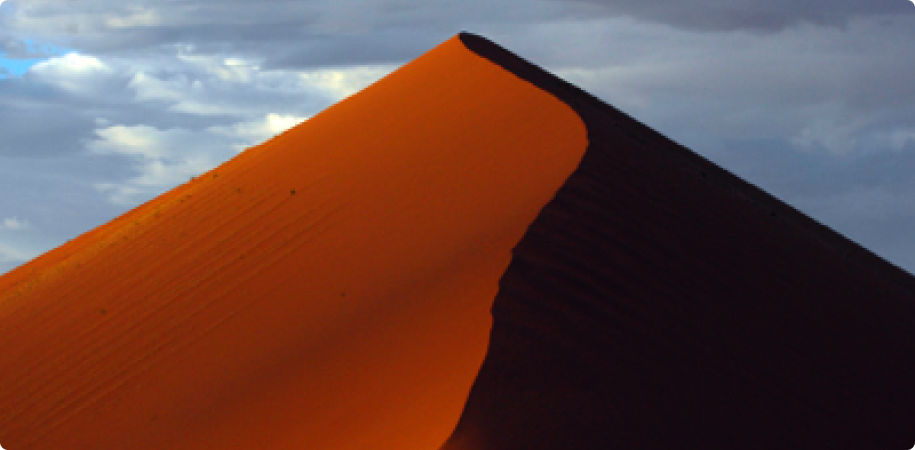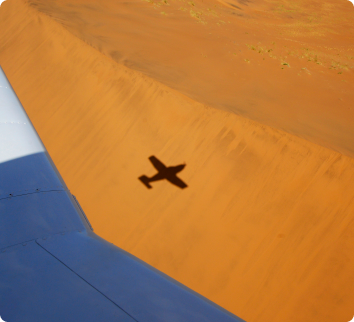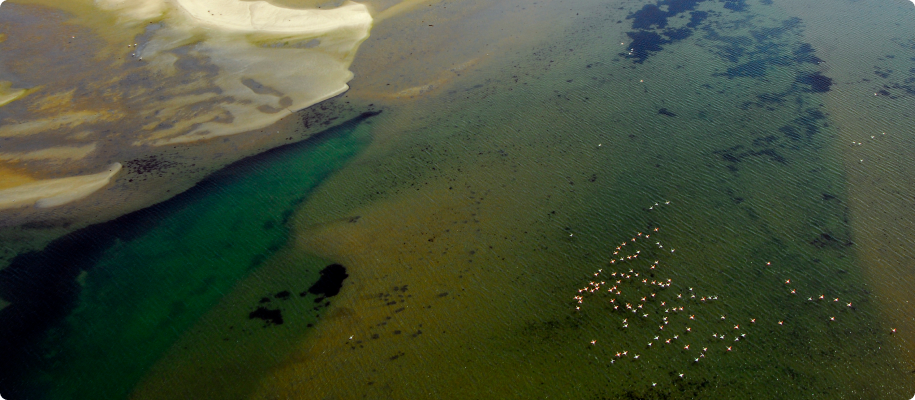Desert Embrace
Expedition – Namibia

A Solitude of Dunes in Sossusvlei, Namibia Draws Adventurers in
The “sossus” in Sossusvlei in Afrikaans means “the place of no return.” The “vlei” in Sossusvlei translates as “marsh.” The marsh of no return. The marsh of no return in the world’s oldest desert – southern Africa’s Namib – which for 1,000 miles along the Atlantic coast of Namibia is one of the harshest, most desolate places on earth – a sea of rolling sand that unfurls in an unbroken immensity of…nothing. Rains that on aver- age fall only once every five to 10 years seep deep to disappear between dunes – the world’s tallest – that over at least 80 million years have grown to soar as high as 1,476 feet. These vast sands, deposited into the Atlantic by the Orange River, moved northward by the Benguela current, and dumped back on land by the surf, have been shifted by the wind farther and farther inland for up to 100 miles. The desolation is staggering. And because virtually no water means virtually no life, certain parts of the Namib are no home for lions and hippos and cheetah; Sossusvlei, the large, dry mud pan at its heart that was created eons ago by a river that in a blink flows after each decade’s rain, is not where you go to awe at giraffe or thrill to big cats or fall in love with the fun of safari.
Sossusvlei is instead where you go if you long to blow your mind.

It is an immensity of wonder, an experience of awe, a sight of sense-shaking, soul- stirring joy. Sossusvlei and its dunes – the two are synonymous – are a two-hour flight from Windhoek, Namibia’s hilly capitol city. Fuel- up here, your last chance at “civilization,” and 120 scenic minutes later alight on the dirt landing strip of private Sossusvlei Mountain Lodge – the ideal home base for your explo- rations (see A Sossusvlei Seduction, page 30). Like most miracles born of planet earth – and these Namib desert dunes certainly qualify as one of nature’s most marvelous acts – “the marsh of no return” is not as it appears. Within the desolation, despite the unkind cli- mate, a delicate, even fragile ecosystem thrives. Life, so starkly absent to the eye, carries on beneath the surface. Some of the world’s rarest and weirdest creatures and plants – an eyeless mole that virtually can swim beneath the sand, for one – have evolved over millennia to take advantage of the extreme days and years that pass with not a single drop of rain.
Fly above such a remarkable ecosystem at work and be amazed. Dead-ahead, to the right and to the left, is the miracle of Sossusvlei itself: rust-red dunes that by early morning and late afternoon (the best times to view) are an otherworldly kaleidoscope of shadowplay. Sunrise, when the vast African sky is a blaze of hue – purples and oranges and blues – and sunset when said sky is streaked with beauty, are also amazing dune-viewing moments. Day by day, eon by eon, the wind continues to shape these towering forms, forcing the sand on the flat, windward slope upward toward the crest; the leeward slope, always steeper, drops to the desert floor in astonishing drama. Some among this collection of wind-sculpted works of nature’s art are petrified – just like the perfectly pre- served trees that can be found in Dead Vlei, a bowl of sorts in the middle of Sossusvlei; a strange and hypnotic draw of a place where for centuries there has not been enough moisture even for decomposition. In death there is so much life when it comes to the Namib. For not only do these petrified dunes, these petrified trees express a beauty almost beyond imagining, but this African region beneath your wings pulsates with the energy of excitement.
Just west of this fascination is the Atlantic and, extending north for miles, the famed Skeleton Coast. Here, immense ocean fogs and strong currents have for centuries caused countless shipwrecks. The skeletons of these ships have been found as far as 164 feet inland as the desert slowly inches westward toward the sea, reclaiming land that to fly over is magnificent to behold. Especially in late afternoon, when the coastal fog offers a sky-show of other worldly drama.
To soar Sossusvlei is also to feel your senses come alive. For instance, above the dunes, where the atmosphere is devoid of moisture, hence distortion, clarity of sight is stunning. How sharp the colors! How truly defined the outlines! Fly here and journey through a sensory high.

Sossusvlei and its dunes are part of Namibia’s Namib Naukluft Park, one of Africa’s largest. In 19,215 square miles the park encompasses much of the desert and the dolomitic Naukluft Mountains, which rise 6,445 feet above savannah grasslands and gypsum and quartz plains. The Kuiseb River runs through, nourishing herds of mountain zebra, gemsbok and springbok (types of ante- lope) and ostrich. But the park’s region where the dunes reign, magical Africa appears quite different. Sesriem Canyon, another Sossusvlei sight, is so-named because early African trekkers had to use six (“ses”) leather thongs to get their buckets to water beneath the sands. Today the canyon’s 100-ft walls create a cave- or tunnel-like fascination that whether seen from the air or via 4×4, a popular desert mode of transportation, remains something entirely awesome.
Soar Sossusvlei and come under a spell of nature’s most strangely majestic creations. Fly Sossusvlei and enter into an experience of true wonder. Get aloft above Sossusvlei and let this remarkable African place “of no return” make perfect sense. For a land so stunning, for dunes so dazzling, will draw you deep, ever deeper into its embrace – an embrace of fascination that at least for a time, however long your flight, will have you wanting to soar among them forever.
For further information on Sossusvlei, visit namibian.org and namibia-travel.net
